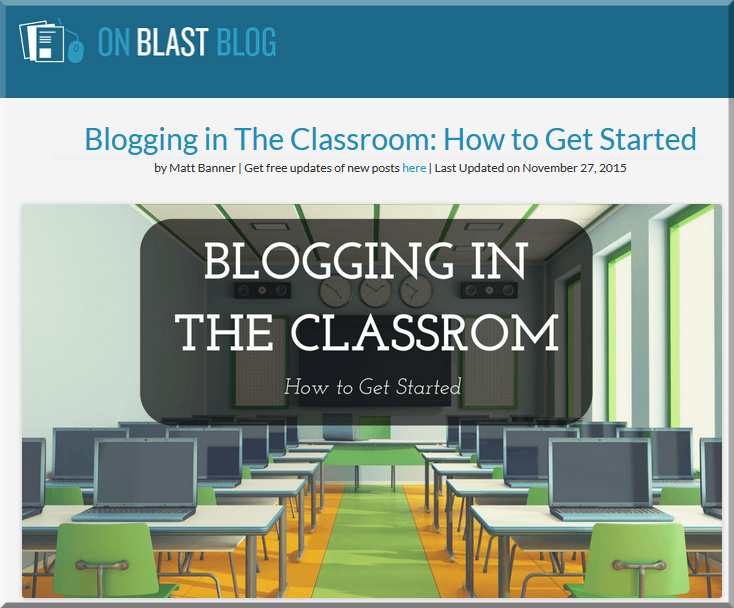Blogging in the classroom: How to get started — from onblastblog.com by Matt Banner
Excerpt:
Here’s what we’ll discuss today:
- Ways to bring blogging into your classroom and daily lesson plans
- The litany of benefits blogging brings to education
- Deciding the purpose and goals of your blog
- Setting up your classroom’s blog
- Easy ways to promote and grow your classroom blog
…
Blogging about a subject turns novices into experts.
There’s no other choice. When you write thousands upon thousands of words about something, doing research all the while, you become an expert in that subject. It’s unavoidable, and possibly the best way to learn in my opinion. Instead of having the information fed to them, students are taking it and putting it down on paper in their own words.
They live the information instead of simply seeing it. This is huge in terms of learning something for the long-term. Hands-on experience will always leave more of a lasting impression than something that is simply boiled down to a few questions on a test.
Michelle Lampinen, a high school English teacher in New Jersey wrote a great article on this here.
Also see:
How blogging is being used in the classroom today: Research results — from emergingtech.com by Mike Wallagher
Excerpt:
The 2015 survey has yet to be reported on, but 2014 research findings have something to say about the state of blogging in the classroom today.
Benefits of Blogging in the Classroom
Blogging in the classroom can have numerous benefits depending on how you use your blog. Just some include that:
- Instructors can create a blog about class happenings so parents can stay up-to-date and students can access announcements from anywhere
- Teachers can use their blogs to store lessons online or provide supplemental learning materials to students
- Instructors can use blogs to organize assignments, such as posting them online for absent students or listing due dates so all students have access to the course materials from anywhere
- Teachers can post previous students’ work as examples or publish current students’ work so they can show parents and family who live far away
- Educators can open the comment sections on blog posts to get feedback from parents and the community as well as to create discussion between students
- Student blogs teach children about writing techniques, online publishing, and proper Internet etiquette, which most students will use in future careers
How Blogs Are Being Used
“Blogging in the classroom” may bring up this idea that there’s one way to present blogging to your students, but there are a myriad of ways educators can use blogs. Just some options include:
- Personal blogs for teachers
- Student blogs
- ePortfolios
- Platforms for assignments, homework, and announcements
- Classroom blogs for collaboration and discussion
From DSC:
Whether your school, university, or college has a web hosting service or whether you need to go out and find a web hosting service yourself — or use a free service/solution — blogging is a great way to create streams of content and to “think out loud.” It offers benefits for students, teachers, professors, staff, and administrators.









